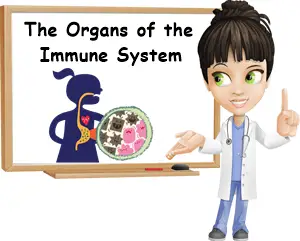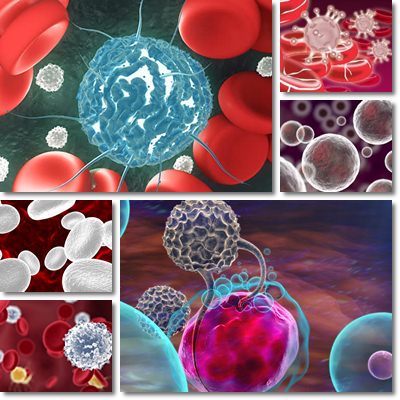Our immune system is made up of a series of mechanisms, reflexes and responses that comprise our body’s defense system. But the mechanisms employed to protect against infection and disease rely on the support of several organs and systems that produce white blood cells, help them mature and stock them for future use, with the purpose of preventing infection and disease. These organs are called lymphoid organs because they contain lymphocytes, a type of white blood cell, and are classified as primary and secondary.
What are the organs of the immune system? The organs of the immune system are the tonsils, the adenoids, the thymus, the lymph nodes, the spleen, the appendix, the associated lymphoid tissues, the bone marrow and the skin. Though not organs per se, the mucous membranes lining various parts of the body also count as immunity organs because they exhibit lymphoid tissue containing a type of white blood cell called lymphocytes. These include mucous membranes in the nose, throat, lungs, bowel, bladder and reproductive organs. Lastly, the lymphatic system is another major component of the immune system, responsible for transporting white blood cells to and from various organs and triggering an immune system response in case of infection with pathogens.

While complex, the activity of the immune system organs is well-regulated and vital for a strong immune system response. There are three classes of immune system organs, grouped as follows:
1) Primary lymphoid organs: the bone marrow and the thymus.
2) Secondary lymphoid organs: the lymph nodes and lymph vessels, spleen, tonsils, adenoids, appendix and skin.
3) Lymphoid tissues: mucous membranes in the nose, throat, lungs, bowel (Peyer’s patches in the small intestine), bladder and reproductive organs.
Associated functions
How do the immune system organs and tissues affect the immune response?
1) The bone marrow. The bone marrow is the spongy tissue found in the core of our bones. There are two types: red and yellow bone marrow. Red bone marrow can be found inside several bones such as the femur, the pelvis, the humerus, the vertebrae, the ribs etc. and produces most of our white blood cells, hence the reason it is called a primary lymphoid organ. After the immature white blood cells leave the bone marrow, they go to secondary lymphoid organs to mature and differentiate, meaning they take on various characteristics and become more specific types of white blood cells (such as B cells, T cells).
2) The thymus. The thymus is an organ in the chest cavity, situated in front of the heart and behind the sternum. The role of the thymus in the immune system is that of primary lymphoid organ, meaning it produces white blood cells. However, the thymus is also an organ where immature white blood cells mature into a more specific type called T cells (T from thymus). What is interesting about the thymus is that it develops till puberty, then it begins to gradually turn into fatty tissue, reducing its size and activity. As its activity decreases, it produces less and less T cells, leaving our blood marrow to produce most of our white blood cells in adulthood.

3) The lymph nodes. Lymph nodes are small, kidney bean-shaped organs found throughout our body. There are up to 600 lymph nodes in the human body. They contain lymph fluid from the lymphatic system, which is filled with lymphocytes, a type of white blood cell. Lymph nodes act as filters, cleaning the lymphatic fluid by activating white blood cells to fight pathogens and cancerous cells. Swollen, inflamed or tender lymph nodes are a sign of an infection or disease, in some cases cancer.
4) The spleen. It’s an organ in the left side of the abdominal cavity. The spleen is mostly known for destroying old red blood cells that have reached the end of their life cycle, storing and filtering blood. Its role in the immune system is that of secondary lymphoid organ, meaning it stocks up on white blood cells. Actually, it has been shown that the spleen contains more than half of the body’s monocytes, a type of white blood cell. The spleen can house 1/4 of the body’s lymphocytes.
The spleen is actually extremely important for the immune system response (see article on the immune system). Research has observed that having your spleen removed increases your risk of infections and related disease. Moreover, a spleen that is not functioning well may negatively impact the function of a type of white blood cell called B cell and disrupt the good functioning of bacteria-eating white blood cells.
5) The appendix. It is a secondary lymphoid organ which contains generous amounts of lymphoid tissue, rich in white blood cells. The appendix is believed to house good bacteria meant to restore intestinal flora in case it is destroyed by an infection. Research has observed that people who have had their appendix removed are more susceptible to infections and disease, most likely because of the role of the appendix in the immune system. It has been theorized that the appendix is responsible for activating B and T cells to fight infection and regulating digestive health via its immune response.
6) The tonsils and the adenoids. The tonsils and adenoids are masses of lymphoid tissue situated in the back of the throat at the sides and at the back of the nasal cavity, where the nose meets the throat. The surface of the tonsils has M cells which detect bacteria, viruses and other pathogens and trigger an immune system response, activating B an T cells residing in the tonsils. Basically, our tonsils block any harmful agent we might inhale, preventing it from going deeper into the body. The tonsils may also produce T cells, but they are primarily reserves of lymphocytes.
The adenoids are also secondary lymphoid tissue and represent a first line of defense against bacteria and viruses that we may breather in. Lingual tonsils, the tiny nodule-like masses at the base of the tongue, have a similar significance and role in the immune system. All three are often connected with more lymphoid tissue and form a ring-like structure that blocks bacteria and viruses from going further into the body.
7) The skin. Just like our tonsils and adenoids, the skin is also a first line of defense against pathogens. By cutting us off from the outside world, our skin acts as a secondary immune system organ and protects us from pathogens. In fact, the skin contains a type of white blood cell called dendritic cells (Langerhans cells, to be more exact). These can be found in all the layers of the skin, except for the outermost one, but also in the mouth and reproductive organs and prevent infection with various pathogens.
8) The bowel. Peyer’s patches are centimeter-long patches of lymphoid tissue in the small intestine. They are called gut-associated lymphoid tissue because they are normally found in the gastrointestinal tract. The Peyer’s patches harbor primarily B cells and T cells, but also dendritic cells and macrophages. They also contain memory cells that remember certain pathogens from previous encounters. When harmful bacteria enter the gastrointestinal tract via contaminated food or water, the immune system at this level activates.
Another part of the gastrointestinal tract involved in the immune system function is the stomach itself. Our stomach acid is incredibly strong and often manages to deal with everyday bacteria and even some parasites and their eggs without much difficulty. Our gut microbiota is also a part of the immune system response.
The significance of gut flora (microbiota) for immunity. The good bacteria in our bowel has been found to interact with both the innate and the adaptive immune system. Basically, our gut flora abounds and makes it difficult for harmful bacteria to settle in, thus giving a helping hand to our immune system. Moreover, a healthy gut flora helps reduce inflammation and lowers the risk of inflammatory conditions of the gastrointestinal tract which may give a hard time to our immune system. In turn, our immune system recognizes the good bacteria in our gut as having the right to be there and benefits from it creating a healthy environment that allows for a felicitous and unaltered distribution of lymphoid tissue.
9) Other associated lymphatic tissues. The mucous membranes lining the nose, throat, lungs, bladder and reproductive organs are not immune system organs, but contain lymphatic tissue with various kind of white blood cells. The bladder and reproductive organs contain a type of white blood cells also found on the skin (dendritic cells known as Langerhans cells). In addition to the presence of lymphatic tissue, the lining of the nose, throat, mouth and lungs all block bacteria, viruses, cell debris and other potentially harmful agents by trapping them in mucus and expelling it afterwards.
10) The liver. It has been discovered that the liver too is capable of producing blood cells. This process occurs during fetal development, when the bone marrow is not yet developed enough to produce red and white blood cells. However, the liver is not considered an immune system organ proper because its immunity-related properties do not normally extend beyond fetal development.
